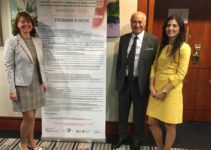Partager la publication "Conditions for success in guided bone regeneration : Retrospective study on 376 Implant Sites"
Paul Mattout et Catherine Mattout.
Background: Used alone or in association with bone, guided bone regeneration is a clinically accepted method to increase the volume of bone during implant placement. Concerns about appropriate surgical techniques and the predictability of the results questions still exists. The aim of this study was to assess the conditions for success.
Methods: Three-hundred-seventy-six implants were placed in association with 214 non-resorbable membranes. In 109 implants, the membrane was secured on a blood clot; for 213 implants, membrane was placed with autogenous bone; and for 54 implants it was placed with allogenic bone. The surgical procedure, the primary closure, the timing of re—entry, and the density of regenerated tissue were studied.
Results: In 19 membranes, barrier exposure occurred before 3 months in these instances, the regenerated tissue was removed; another 7 membranes were exposed between 3 and 6 months. The 188 non-exposed membranes were removed between 6 and 12 months. In cases of exposure before 3 months, the regenerated tissue was soft and then removed. After closure for 6 months or more, the renegerated tissue was dense and resistant to probe pressure. The best results were obtained when the membranes were placed with autogenous bone.
Conclusions: If all the clinical steps are appropriately followed, guided bone regeneration using an autogenous bone graft and implant placement is a predictable technique for increasing bone volume.
Guided bone regeneration is a clinically accepted method of increasing the volume‘of bone at sites selected for implant placement.
Recently the combination of autogeniccortico cancellous bone graft and guided bone regeneration has proven highly successful.
The autogenous bone graft not only creates space, but also acts as an osteo-conductive scaffold to accelerate bone regeneration.
Mellonig and Triplett have demonstrated the efficiency of using demineralized freeze dried bone with barrier membranes.
The purpose of this retrospective study Was to evaluate the effects of expanded polytetrafluoroethylene (ePTFE) membranes used alone or in association, with autogenous or allogenic bone on bone regeneration and to evaluate the success by studying the surgical procedure, the primary closure, the timing of re-entry, and the density of regenerated tissue.
MATERIALS AND METHODS
In the present study 376 implantsT (283 in the maxilla and 93 in the mandible) were placed in 135 patients aged between 20 to 80 in association with 214 non-resorbable ePTFE membranes}
This study was conducted from 1990 to 1998. At the begining of the study, non-reinforced membranes were need and after 1995 titanium-reinforced membranes were preferred.
To cover large defects and to avoid the membrane collapse, titanium support screws of various lengths were used. For 109 implants, the membrane was secured on the blood clot; in 213 implants, the membrane was associated with autogenous bone, and for 54 implants it was associated with allogenic bone.
Autogenous bone was collected from the osseous coagulum trap (OCT) during the preparation of the implant site. When necessary, an autogenous bone block was obtained from the chin. In some cases the associated material was demineralized freeze-dried bone allograft.

